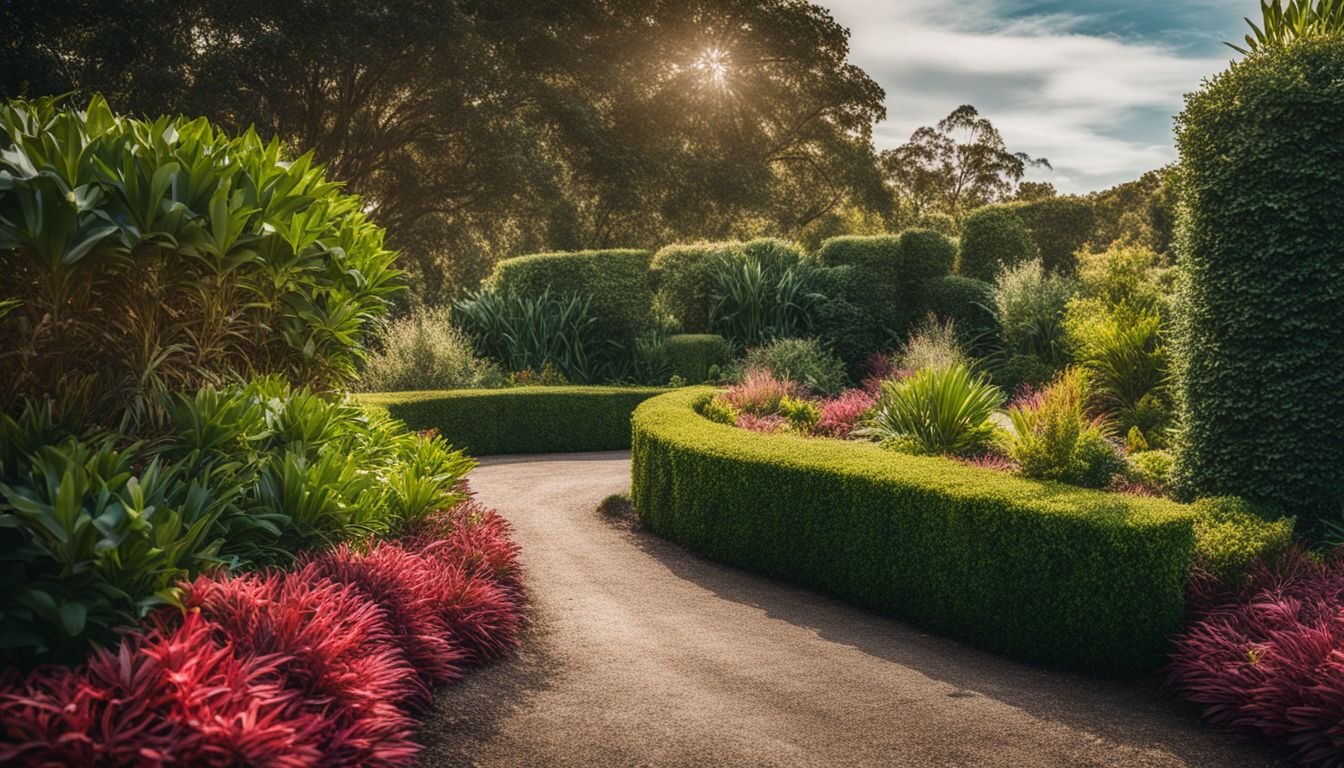Are you eyeing that bare fence in your backyard and reckon it could do with a bit of greenery? You’re definitely not on your own there. A fair few Aussies reckon their outdoor spaces could do with a bit more privacy and charm.
We’ve found ourselves in the same boat, looking at a plain old fence, dreaming of something to give it life and privacy. Well, we’ve got some ripper news for you: planting native hedge plants is just the trick to turn any dull space into your very own garden sanctuary.
Through our digging around for info, we stumbled upon Lilly Pilly as a top-notch choice among native plants for crafting lush hedges. She’s quick to grow and brings the goods when it comes to privacy, not to mention she’ll brighten up your garden with her edible fruit – even though she might attract pests like psyllids and scale every now and then.
Our guide lays out simple steps on picking the best plants for your hedge so they flourish right in your backyard. This way, you get the best of both worlds – stunning looks and practicality from your new leafy barrier.
Keen to dive in? Keep reading!
Key Takeaways
- Lilly Pilly, Photinia, and the Australian Tea Tree stand out as the best native plants for creating a fence hedge because they grow quickly and offer both privacy and beauty.
- Proper care like watering, fertilising in spring, and regular trimming will keep your hedge looking great. Also, watch out for pests which can damage plants if not controlled.
- Native plants like Bay Tree provide benefits beyond good looks; they support local wildlife by offering food and shelter, enhancing garden biodiversity.
- Planting bottlebrush attracts birds with their vibrant flowers, making gardens lively while also serving as an effective natural barrier.
- Choosing natives for hedges means less water use and maintenance since these plants are adapted to the Australian climate, making gardening more enjoyable.
The Importance of Hedges in Australian Backyards

Hedges act as stunning natural barriers in our backyards. They do more than just add beauty; they offer privacy and can make a home much more valuable. We know that deciding on the right hedge involves thinking about how tall it should be to keep prying eyes out, how thick we want it for fullness, and how quickly it needs to grow to meet our needs soon.
We also consider the type of earth it will thrive in, how frost might affect it during cold spells, and whether its branches or leaves could get damaged during backyard cricket matches.
We always chat with local nurserymen who give us great advice on which plants work best for our unique conditions. They remind us to prepare the soil with compost before sowing seeds or planting young trees like lilly pillies or pittosporum tenuifolium.
Regular applications of liquid fertiliser ensure our hedges get all the nutrients they need to flourish. Using organic mulch around the base helps retain moisture and keeps roots cool during hot summers.
It’s all about creating a living fence that not only looks good but also serves as a sanctuary for birds and beneficial insects, contributing positively to local biodiversity.
Top Native Australian Plants for Hedges

We all want our gardens to stand out and native Australian plants can do just that for your fence hedge. Among them, lilly pillys shine as they grow thick and fast, providing privacy in no time.
Photinias add a splash of colour with their red leaves while the Australian tea tree offers lush greenery that’s hard to beat. Pittosporums form dense barriers that are perfect for any garden design, and bottlebrushes attract birds with their vibrant flowers.
Caring for these plants involves simple steps like preparing the soil properly and ensuring they get enough plant nutrients. Whether you’re looking to create a lively barrier or just add some green to your outdoor space, choosing these Australian natives will surely bring life to your backyard.
Lilly Pilly
Lilly Pilly makes a fantastic choice for gardeners who want to grow a dense, fast-growing hedge. This Australian native plant offers lush foliage and produces edible fruits that can add a unique touch to your yard.
Thanks to its rapid growth rate, you’ll enjoy privacy in no time. Garden design often includes these vibrant plants for both their beauty and practicality.
However, lilly pillys do face challenges from pests such as psyllids and scale insects. Proper soil preparation and applying lime sulphur can help keep these problems at bay, ensuring your plants stay healthy and strong.
It’s crucial to keep an eye out for signs of infestation so you can act quickly. Feeding your lilly pilly with the right plant nutrients will also support its development into a thick and hearty hedge.
Moving on from lilly pilly, let’s explore another excellent option for creating hedges – Photinia.
Photinia
We all cherish a good hedge in our gardens, and Photinia stands out as a trusty option. Its resilience shines through its ability to withstand frost, survive long dry spells, and even tolerate salty coastal breezes.
For those of us looking for a plant that battles the elements alongside us, Photinia steps up to the challenge.
The new variety of this plant, Photinia robusta x serraluta ‘Black Jack’, brings something special to modern homes with its dark foliage. This variant not only survives but thrives under diverse conditions, making it perfect for adding a contemporary touch to landscapes.
Whether you’re aiming for privacy or simply enhancing your garden’s aesthetic, ‘Black Jack’ offers both functionality and style without demanding constant attention from busy homeowners.
Australian Tea Tree
We often include the Australian Tea Tree in our hedges for its resilience and beauty. This plant thrives in different soil types, making it ideal for various gardens across Australia.
Its small leaves and ability to bloom with delicate flowers add a unique texture and colour contrast to hedge rows.
The care for this tree involves regular trimming to maintain shape and encourage denser growth. Watering them during dry spells keeps them healthy, but they are quite drought-tolerant once established.
For a standout fence hedge that withstands the test of time, incorporating the Australian Tea Tree is a smart choice.
Pittosporum
Pittosporum, particularly Pittosporum tenuifolium ‘Silver Sheen’, is a standout choice for Australians looking to grow hedges. Its small, dense leaves carry a unique silver tint that catches the eye.
This plant forms thick barriers quickly and adds an elegant touch of greenery to any garden space.
We love using Pittosporum in our landscape designs because it pairs well with other Australian native plants. It creates privacy without sacrificing aesthetics. For those who run nurseries or are keen home gardeners, this species provides an excellent option for adding structure to your outdoor areas.
Caring for Pittosporum involves regular pruning to maintain its shape and encourage denser growth. It thrives in well-drained soil and enjoys full sun to partial shade, making it adaptable to various garden settings.
With these simple care tips, you’ll have a flourishing hedge that enhances your backyard’s natural beauty.
Bottlebrush
Bottlebrush plants shine as top choices for Australian hedges due to their vibrant, unique flowers that resemble a brush used for cleaning bottles. These native shrubs burst into brilliant displays of red, attracting birds and bees to your garden.
They make a lively fence hedge that not only looks stunning but also supports local wildlife.
We often choose these hardy shrubs because they’re resilient in various conditions and bring a splash of color to our backyards throughout the year. The bottlebrush thrives in full sunshine and doesn’t shy away from drought, making it perfect for the Australian climate.
With minimal care, they grow quickly, providing privacy and beauty in no time.
“A garden without Bottlebrush is like an ocean without water – missing its essence.”
Planting them involves selecting the right spot where they can soak up plenty of sunlight while having enough space to spread their roots. Regular trimming helps maintain their shape and encourages denser growth, creating a fuller hedge faster.
Whether you’re a seasoned nurseryman or new to gardening with natives like ficus hillii or bay trees, adding bottlebrushes to your landscape brings instant charm and vibrancy.
How to Care for Your Hedge
Caring for your hedge is key to keeping it healthy and making sure it looks great. Here’s how we do it, from watering to cutting.
- Water your plants well, especially during dry spells. Young plants need more moisture to help them settle in.
- Use a good fertiliser in spring. This helps the plants grow strong and healthy.
- Trim your hedge regularly to keep its shape. For most plants, trimming twice a year works well.
- Check for pests often and deal with them quickly. Pests can harm your hedge if left unchecked.
- Make sure the soil drains well, so roots don’t sit in water. If drainage is poor, consider improving it or choosing plants that cope better with wet feet.
- Protect young, frost – sensitive plants like Indian laurel from cold snaps with cloth covers.
- Mulch around the base of your plants to keep moisture in and weeds out.
- Pick varieties that suit your climate and garden space. Some hedges need more room than others.
With these steps, we guide our hedges toward becoming beautiful boundaries for our gardens.
Benefits of Choosing Native Plants for Hedges
We all love a garden that needs less work but still looks great. Native plants for hedges tick this box perfectly. Plants like Lilly Pilly adapt well to our climate and soil, meaning they grow strong without us needing to water them too much or fuss over them.
This makes gardening easier and more enjoyable for us.
Choosing natives like the Bay Tree not only gives us beautiful, glossy leaves and stunning flowers; it also helps our local wildlife. These plants provide food and shelter for native birds and insects, making our gardens a haven for biodiversity.
Plus, some of these plants offer extra perks like bay leaves we can use in cooking or Lilly Pilly fruit we can eat straight from the hedge. We get to create lovely fence borders that benefit both us and nature around us.
Conclusion
Choosing the right native plants for your fence hedge can make your garden stand out. Lilly Pilly, Photinia, and the Australian Tea Tree are great picks. They grow quickly and add beauty to any space.
Caring for these plants is easy too. Give them water, good soil, and a bit of love, and watch them thrive. Pick native plants for your hedges; they’re perfect for adding privacy and style to your Australian backyard.
FAQs
1. What are some Australian native plants suitable for a fence hedge?
Ficus microcarpa and Juniperus virginiana are excellent choices for creating a dense, green fence hedge in Australia.
2. Can you use vegetables to make a living fence in Australia?
Yes, certain vegetables can grow tall and thick enough to form a living barrier, adding both beauty and practicality to your garden.
3. Is Ficus microcarpa good for privacy hedges?
Absolutely! Ficus microcarpa grows quickly and densely, making it an ideal plant for those seeking privacy with their hedge.
4. Why might someone choose Juniperus virginiana as a street tree or hedge?
Juniperus virginiana is not only beautiful but also tough; it’s perfect as a coniferous street tree or hedge because of its resilience and attractive foliage.
